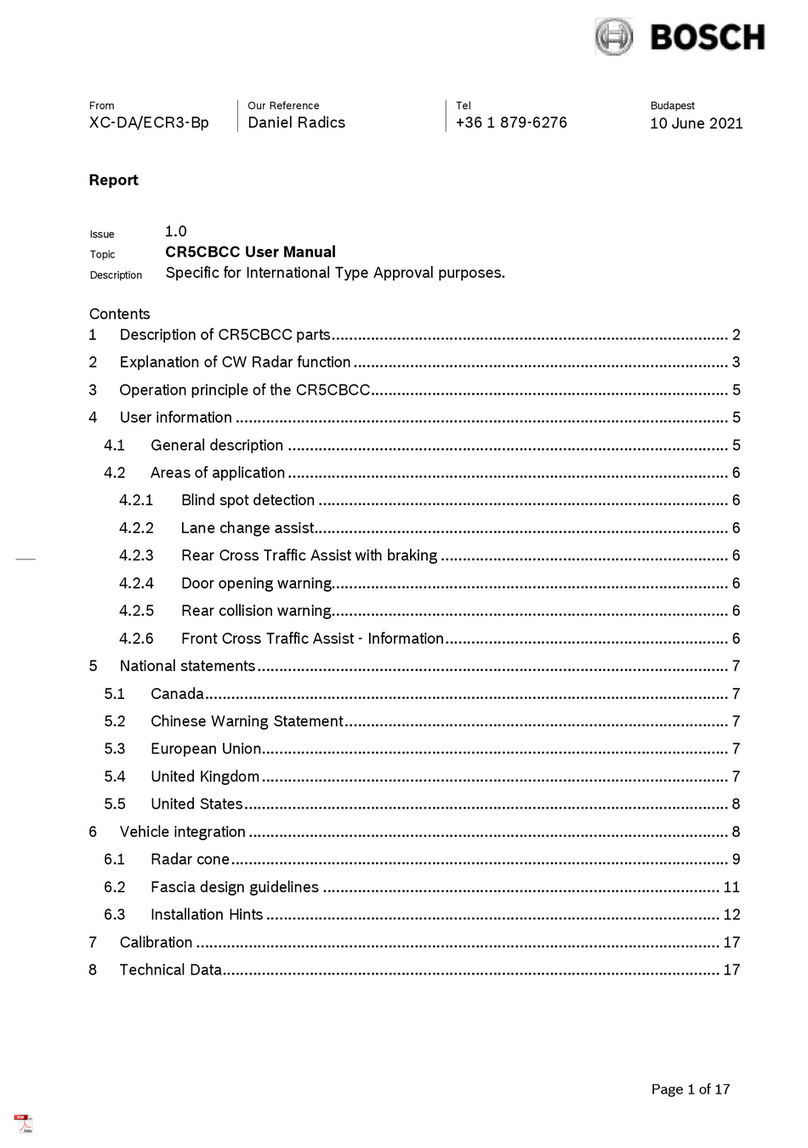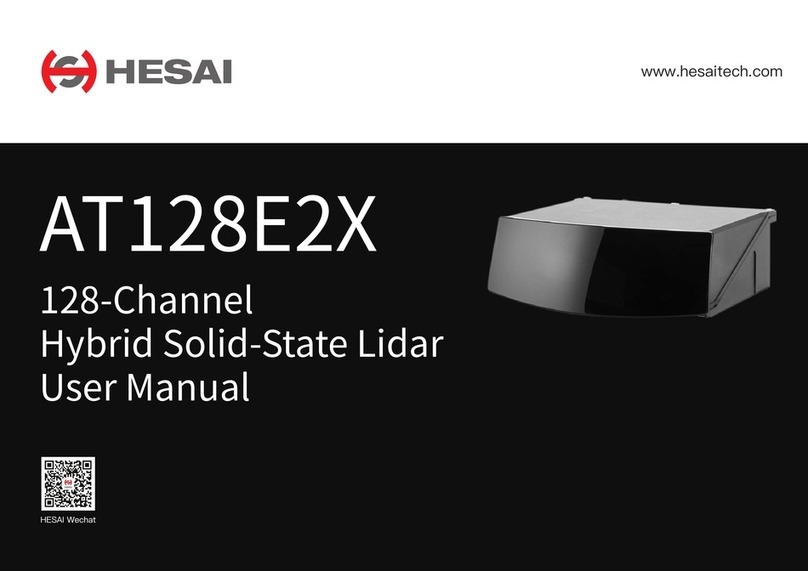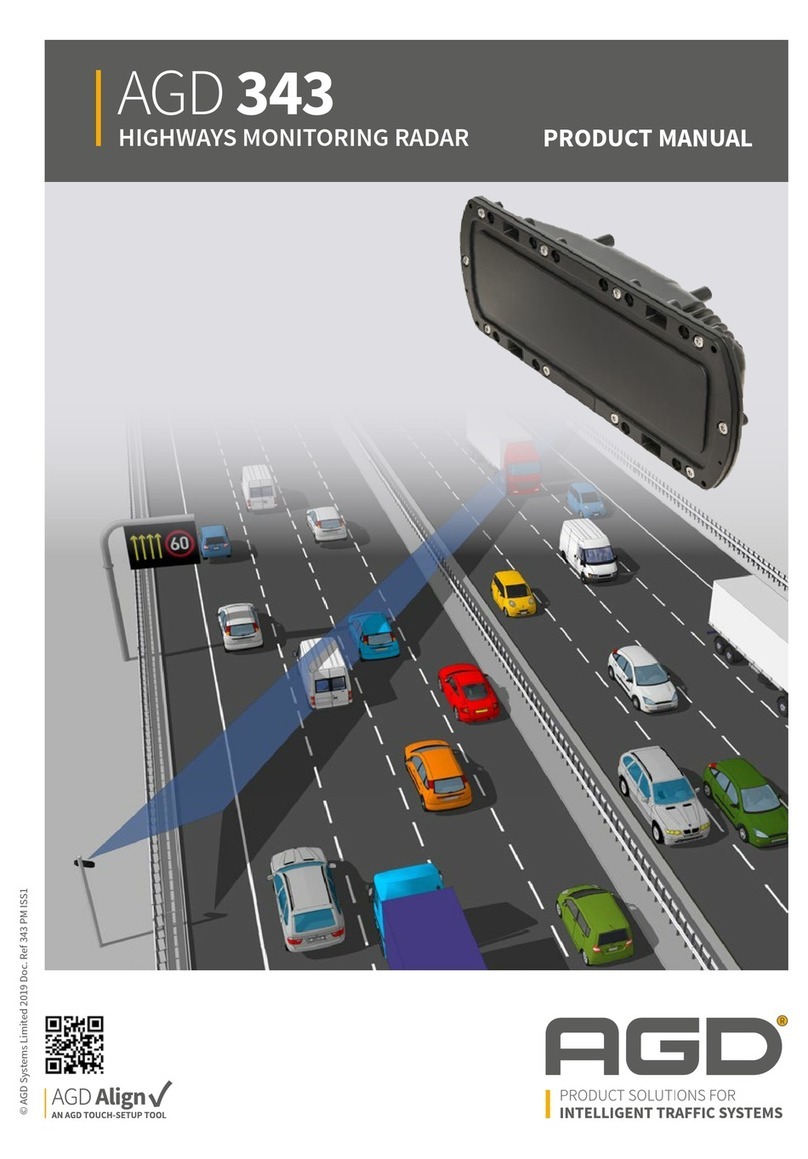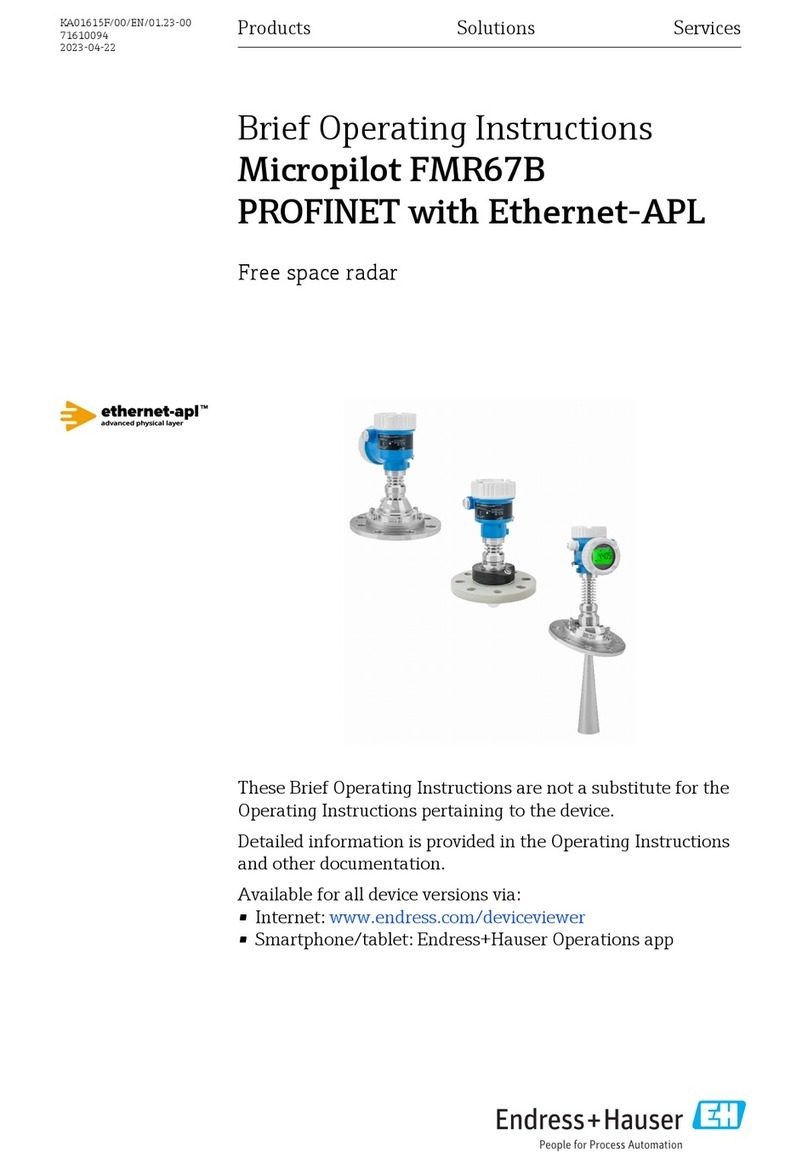Bosch CR5CPCCF User manual

Installation and Manual Documentation
Document date:
CC-DA/ESR1
CR5CPCCF
18 Feb 2020
Page:
1
© All rights reserved, Robert Bosch GmbH, also for the case of protected rights applications every power of disposal, like copy-right
and passing on rights, with us. The valid issue of this template is filed in CC-DA process landscape.
Product identification Product name
CR5CPCCF
Type designation
Corner Radar 5 Car Plus CAN CAN Flexray
Series parts number
Number of the offer drawing
Name of customer
Number, issue/version, date, and title of
the customer specification
TCD Extract
Version and date of the TCD
Version 1.0 (initial) –18.02.2020
Issued by
Robert Bloch
Internal Bosch Baseline ID

Installation and Manual Documentation
Document date:
CC-DA/ESR1
CR5CPCCF
18 Feb 2020
Page:
2
© All rights reserved, Robert Bosch GmbH, also for the case of protected rights applications every power of disposal, like copy-right
and passing on rights, with us. The valid issue of this template is filed in CC-DA process landscape.
Table of contents
1. General product description.................................................................................................3
1.1. Main functions and properties of the product ................................................................3
1.1.1. Principle ................................................................................................................3
1.1.2. Block diagram........................................................................................................4
1.1.3. Preliminary Assembly concept...............................................................................5
1.2. Labeling of the product.................................................................................................6
1.2.1. Radio Frequency Homologation ............................................................................6
1.2.1.1. Phrases and Markings....................................................................................6
1.3. Dimensions and weights.............................................................................................13
1.4. Power consumption / power output............................................................................. 13
1.5. General remarks for service, repair and maintenance ................................................13
1.6. Information on disposal and recycling.........................................................................13
2. System description ............................................................................................................14
2.1. Vehicle integration interfaces......................................................................................14
2.1.1.1. Radar Cone..................................................................................................14
2.1.1.2. Fascia design guidelines ..............................................................................16
2.1.1.3. Installation Hints...........................................................................................18
3. Technical data with measured variables and measuring conditions...................................22
3.1. Mechanical characteristics..........................................................................................22
3.2. Electrical characteristics .............................................................................................23
3.2.1. Electrical Vehicle Connector Pinning ...................................................................24
3.2.1.1. Pin Properties............................................................................................... 24
3.2.1.2. Pin Assignment ............................................................................................24
3.2.2. Vehicle Power Supply..........................................................................................25
3.2.2.1. Constraints and Definitions...........................................................................25
3.2.2.2. Power Supply System 12V ...........................................................................25
3.2.3. Mounting recognition ...........................................................................................26

Installation and Manual Documentation
Document date:
CC-DA/ESR1
CR5CPCCF
18 Feb 2020
Page:
3
© All rights reserved, Robert Bosch GmbH, also for the case of protected rights applications every power of disposal, like copy-right
and passing on rights, with us. The valid issue of this template is filed in CC-DA process landscape.
1. General product description
The present technical customer documentation describes CR5CPCCF, for which the Robert
Bosch GmbH has the assigned responsibility. In addition, it contains noncommittal descriptions
of components and functionalities, which are not in the responsibility of Robert Bosch GmbH, but
nonetheless determine or influence the behavior and performance of the particular vehicle type
series.
1.1. Main functions and properties of the product
1.1.1. Principle
The CR5CP radar sensor and control unit (SCU) contains a FMCW radar transceiver operating
in the globally harmonized frequency range of 76.0 - 77.0 GHz. It senses targets by emitting many
short frequency modulated waves using the transmit antennas while receiving waves reflected by
targets using the receive antennas. Distance and relative speed are determined via beat
frequency (due to travelling time of the waves) and phase differences between ramps (due to
change of distance in short time). By using the antenna diagram the angles of departure and
arrival of the radar waves can be determined.
Using the Bosch chirp sequence radar modulation, the CR5CP allows unambiguous
determination of relative speed in a single measurement cycle. Therefore, no complex object
models are needed for ambiguity resolution.
The radar reflections (strength, distance and relative speed, angular direction, and derived
values) are basis for building a comprehensive model of the sensed environment.

Installation and Manual Documentation
Document date:
CC-DA/ESR1
CR5CPCCF
18 Feb 2020
Page:
4
© All rights reserved, Robert Bosch GmbH, also for the case of protected rights applications every power of disposal, like copy-right
and passing on rights, with us. The valid issue of this template is filed in CC-DA process landscape.
1.1.2. Block diagram
Figure: Block diagram
The CR5CPCCF sensor is build on a single printed circuit board with integrated components:
•Microcontroller (M-Device) with multi-core architecture and dedicated radar signal
processing unit (SPU), Flash and RAM memory, peripheral units, CAN transceiver, as well as
safety features
•Radar Frontend MMIC in SiGe technology for frequency generation (VCO, PLL and
sequencer), power amplifiers (PA) and receiver including mixer, analog frontend processing, ADC
and digital frontend processing with digital baseband interface to the microcontroller as well as
clock generation and safety features
•Planar antenna array with three transmit antennas and four receive antennas
•A System-ASIC with power supply for internal voltages (except microcontroller core power
supply), a safety controller (SCON) with watchdog functionality and CAN-transceiver
•FlexRay PHY (transceiver)

Installation and Manual Documentation
Document date:
CC-DA/ESR1
CR5CPCCF
18 Feb 2020
Page:
5
© All rights reserved, Robert Bosch GmbH, also for the case of protected rights applications every power of disposal, like copy-right
and passing on rights, with us. The valid issue of this template is filed in CC-DA process landscape.
1.1.3. Preliminary Assembly concept
Figure: Assembly concept
With only 3 main components (radome, PCB, lower housing), the assembly of the CR5CP SCU
is quite simple and is focusing to robust and cost effective mass production.

Installation and Manual Documentation
Document date:
CC-DA/ESR1
CR5CPCCF
18 Feb 2020
Page:
6
© All rights reserved, Robert Bosch GmbH, also for the case of protected rights applications every power of disposal, like copy-right
and passing on rights, with us. The valid issue of this template is filed in CC-DA process landscape.
1.2. Labeling of the product
The radar devices provide information about:
- part-number
- series-number
- hardware and software version
- barcode information
- production date
- radar emission release information
- customer information
1.2.1. Radio Frequency Homologation
1.2.1.1. Phrases and Markings
The following phrases and markings are part of the radio frequency homologation and have to be
reproduced in the vehicle user manual.
1.2.1.1.1. Australia
1.2.1.1.2. Qatar
1.2.1.1.3. South Africa
1.2.1.1.4. Singapore
1.2.1.1.5. Ukraine
1.2.1.1.6. Serbia
1.2.1.1.7. Moldova
1.2.1.1.8. Mexico
1.2.1.1.9. Phillipines
1.2.1.1.10. Indonesia
1.2.1.1.11. Brunei Daressalam
1.2.1.1.12. Jordania
1.2.1.1.13. United Arabic Emirates
1.2.1.1.14. Morocco

Installation and Manual Documentation
Document date:
CC-DA/ESR1
CR5CPCCF
18 Feb 2020
Page:
7
© All rights reserved, Robert Bosch GmbH, also for the case of protected rights applications every power of disposal, like copy-right
and passing on rights, with us. The valid issue of this template is filed in CC-DA process landscape.
1.2.1.1.15. Malaysia
1.2.1.1.16. South Korea
1.2.1.1.17. Brazil
1.2.1.1.18. Taiwan
1.2.1.1.19. China
1.2.1.1.20. Hong Kong
1.2.1.1.21. Japan
1.2.1.1.22. Europe
In order to obtain CE marking, compliance to the essential requirements of the Radio Equipment
Directive (2014/53/EU) have to be demonstrated.
Therefore a Declaration of Conformity (DoC), listing the applied standards to fulfill the essential
requirements of the Radio Equipment Directive (2014/53/EU), will be made available in the Robert
Bosch GmbH - DoC Database - for download under the following link: http://eu-doc.bosch.com
The European homologation mark will be applied on the sensor.
European homologation mark according to Radio Equipment Directive (RE-D) 2014/53/EC:
Legal text for RF equipment (simplified DoC) translated in all official EU languages::
(EN) EC DECLARATION OF CONFORMITY
Hereby, Robert Bosch GmbH declares that the radio equipment type CR5CPCCF is in compliance
with Directive 2014/53/EU. The full text of the EU declaration of conformity is available at the
following internet address: http://eu-doc.bosch.com
(DE) EU-KONFORMITÄTSERKLÄRUNG
Hiermit erklärt Robert Bosch GmbH, dass der Funkanlagentyp CR5CPCCF der Richtlinie
2014/53/EU entspricht. Der vollständige Text der EU-Konformitätserklärung ist unter der
folgenden Internetadresse verfügbar: http://eu-doc.bosch.com

Installation and Manual Documentation
Document date:
CC-DA/ESR1
CR5CPCCF
18 Feb 2020
Page:
8
© All rights reserved, Robert Bosch GmbH, also for the case of protected rights applications every power of disposal, like copy-right
and passing on rights, with us. The valid issue of this template is filed in CC-DA process landscape.
(BG) ЕС ДЕКЛАРАЦИЯ ЗА СЪОТВЕТСТВИЕ
С настоящото Robert Bosch GmbH декларира, че този тип радиосъоръжение CR5CPCCF е
в съответствие с Директива 2014/53/ЕС. Цялостният текст на ЕС декларацията за
съответствие може да се намери на следния интернет адрес: http://eu-doc.bosch.com
(HR) EU IZJAVA O SUKLADNOSTI
Robert Bosch GmbH ovime izjavljuje da je radijska oprema tipa CR5CPCCF u skladu s
Direktivom 2014/53/EU. Cjeloviti tekst EU izjave o sukladnosti dostupan je na sljedećoj
internetskoj adresi: http://eu-doc.bosch.com
(EL) ΔΗΛΩΣΗ ΣΥΜΜΟΡΦΩΣΗΣ ΕΕ
Με την παρούσα ο/η Robert Bosch GmbH, δηλώνει ότι ο ραδιοεξοπλισμός CR5CPCCF πληροί
την οδηγία 2014/53/ΕΕ. Το πλήρες κείμενο της δήλωσης συμμόρφωσης ΕΕ διατίθεται στην
ακόλουθη ιστοσελίδα στο διαδίκτυο: http://eu-doc.bosch.com
(CS) EU PROHLÁŠENÍ O SHODĚ
Tímto Robert Bosch GmbH prohlašuje, že typ rádiového zařízení CR5CPCCF je v souladu se
směrnicí 2014/53/EU. Úplné znění EU prohlášení o shodě je k dispozici na této internetové
adrese: http://eu-doc.bosch.com
(DA) EU-OVERENSSTEMMELSESERKLÆRING
Hermed erklærer Robert Bosch GmbH, at radioudstyrstypen CR5CPCCF er i overensstemmelse
med direktiv 2014/53/EU. EU-overensstemmelseserklæringens fulde tekst kan findes på
følgende internetadresse: http://eu-doc.bosch.com
(ET) ELI VASTAVUSDEKLARATSIOON
Käesolevaga deklareerib Robert Bosch GmbH, et käesolev raadioseadme tüüp CR5CPCCF
vastab direktiivi 2014/53/EL nõuetele. ELi vastavusdeklaratsiooni täielik tekst on kättesaadav
järgmisel internetiaadressil: http://eu-doc.bosch.com
(FI) EU- VAATIMUSTENMUKAISUUSVAKUUTUS
Robert Bosch GmbH vakuuttaa, että radiolaitetyyppi CR5CPCCF on direktiivin 2014/53/EU
mukainen. EU-vaatimustenmukaisuusvakuutuksen täysimittainen teksti on saatavilla
seuraavassa internetosoitteessa: http://eu-doc.bosch.com
(FR) DECLARATION UE DE CONFORMITE
Le soussigné, Robert Bosch GmbH, déclare que l'équipement radioélectrique du type
CR5CPCCF est conforme à la directive 2014/53/UE. Le texte complet de la déclaration UE de
conformité est disponible à l'adresse internet suivante: http://eu-doc.bosch.com

Installation and Manual Documentation
Document date:
CC-DA/ESR1
CR5CPCCF
18 Feb 2020
Page:
9
© All rights reserved, Robert Bosch GmbH, also for the case of protected rights applications every power of disposal, like copy-right
and passing on rights, with us. The valid issue of this template is filed in CC-DA process landscape.
(HU) EU-MEGFELELŐSÉGI NYILATKOZAT
Robert Bosch GmbH igazolja, hogy a CR5CPCCF típusú rádióberendezés megfelel a
2014/53/EU irányelvnek. Az EU-megfelelőségi nyilatkozat teljes szövege elérhető a következő
internetes címen: http://eu-doc.bosch.com
(IT) DICHIARAZIONE DI CONFORMITÀ UE
Il fabbricante, Robert Bosch GmbH, dichiara che il tipo di apparecchiatura radio CR5CPCCF è
conforme alla direttiva 2014/53/UE. Il testo completo della dichiarazione di conformità UE è
disponibile al seguente indirizzo Internet http://eu-doc.bosch.com
(LV) ES ATBILSTĪBAS DEKLARĀCIJA
Ar šo Robert Bosch GmbH deklarē, ka radioiekārta CR5CPCCF atbilst Direktīvai 2014/53/ES.
Pilns ES atbilstības deklarācijas teksts ir pieejams šādā interneta vietnē: http://eu-
doc.bosch.com
(LT) ES ATITIKTIES DEKLARACIJA
Aš, Robert Bosch GmbH, patvirtinu, kad radijo įrenginių tipas CR5CPCCF atitinka Direktyvą
2014/53/ES. Visas ES atitikties deklaracijos tekstas prieinamas šiuo interneto adresu: http://eu-
doc.bosch.com
(MT) DIKJARAZZJONI TA' KONFORMITÀ TAL-UE
B'dan, Robert Bosch GmbH, niddikjara li dan it-tip ta' tagħmir tar-radju CR5CPCCF huwa
konformi mad-Direttiva 2014/53/UE. It-test kollu tad-dikjarazzjoni ta' konformità tal-UE huwa
disponibbli f'dan l-indirizz tal-Internet li ġej: http://eu-doc.bosch.com
(NL) EU-CONFORMITEITSVERKLARING
Hierbij verklaar ik, Robert Bosch GmbH, dat het type radioapparatuur CR5CPCCF conform is
met Richtlijn 2014/53/EU. De volledige tekst van de EU-conformiteitsverklaring kan worden
geraadpleegd op het volgende internetadres: http://eu-doc.bosch.com
(PL) DEKLARACJA ZGODNOŚCI UE
Robert Bosch GmbH niniejszym oświadcza, że typ urządzenia radiowego CR5CPCCF jest
zgodny z dyrektywą 2014/53/UE. Pełny tekst deklaracji zgodności UE jest dostępny pod
następującym adresem internetowym: http://eu-doc.bosch.com
(PT) DECLARAÇÃO UE DE CONFORMIDADE
O(a) abaixo assinado(a) Robert Bosch GmbH declara que o presente tipo de equipamento de
rádio CR5CPCCF está em conformidade com a Diretiva 2014/53/UE. O texto integral da
declaração de conformidade está disponível no seguinte endereço de Internet: http://eu-
doc.bosch.com

Installation and Manual Documentation
Document date:
CC-DA/ESR1
CR5CPCCF
18 Feb 2020
Page:
10
© All rights reserved, Robert Bosch GmbH, also for the case of protected rights applications every power of disposal, like copy-right
and passing on rights, with us. The valid issue of this template is filed in CC-DA process landscape.
(RO) DECLARAȚIA UE DE CONFORMITATE
Prin prezenta, Robert Bosch GmbH declară că tipul de echipamente radio CR5CPCCF este în
conformitate cu Directiva 2014/53/UE. Textul integral al declarației UE de conformitate este
disponibil la următoarea adresă internet: http://eu-doc.bosch.com
(SK) EÚ VYHLÁSENIE O ZHODE
Robert Bosch GmbH týmto vyhlasuje, že rádiové zariadenie typu CR5CPCCF je v súlade so
smernicou 2014/53/EÚ. Úplné EÚ vyhlásenie o zhode je k dispozícii na tejto internetovej adrese:
http://eu-doc.bosch.com
(SL) IZJAVA EU O SKLADNOSTI
Robert Bosch GmbH potrjuje, da je tip radijske opreme CR5CPCCF skladen z Direktivo
2014/53/EU. Celotno besedilo izjave EU o skladnosti je na voljo na naslednjem spletnem
naslovu: http://eu-doc.bosch.com
(ES) DECLARACIÓN UE DE CONFORMIDAD
Por la presente, Robert Bosch GmbH declara que el tipo de equipo radioeléctrico CR5CPCCF
es conforme con la Directiva 2014/53/UE. El texto completo de la declaración UE de conformidad
está disponible en la dirección Internet siguiente: http://eu-doc.bosch.com
(SV) EU-FÖRSÄKRAN OM ÖVERENSSTÄMMELSE
Härmed försäkrar Robert Bosch GmbH att denna typ av radioutrustning CR5CPCCF
överensstämmer med direktiv 2014/53/EU. Den fullständiga texten till EU-försäkran om
överensstämmelse finns på följande webbadress: http://eu-doc.bosch.com

Installation and Manual Documentation
Document date:
CC-DA/ESR1
CR5CPCCF
18 Feb 2020
Page:
11
© All rights reserved, Robert Bosch GmbH, also for the case of protected rights applications every power of disposal, like copy-right
and passing on rights, with us. The valid issue of this template is filed in CC-DA process landscape.
1.2.1.1.23. USA
Once FCC approval is granted for CR5CPCCF, the following FCC ID has to be included in the
vehicle user manual and labelled on the product.
FCC ID: NF3-CR5CPCCF
The following warning text for RF equipment has to be included in the vehicle user manual:
User Manual statement according to §15.19
This device complies with Part 15 of the FCC Rules. Operation is subject to the following two
conditions:
1. this device may not cause harmful interference, and
2. this device must accept any interference received, including interference that
3. may cause undesired operation.
User Manual statement according to §15.21:
Changes or modifications made to this equipment not expressly approved by Robert BOSCH
GmbH may void the FCC authorization to operate this equipment.
User Manual statement according to §15.105:
This equipment has been tested and found to comply with the limits for a Class A digital device,
pursuant to Part 15 of the FCC Rules. These limits are designed to provide reasonable protection
against harmful interference when the equipment is operated in a commercial environment. This
equipment generates, uses, and can radiate radio frequency energy and, if not installed and used
in accordance with the instruction manual, may cause harmful interference to radio
communications. Operation of this equipment in a residential area is likely to cause harmful
interference in which case the user will be required to correct the interference at his own expense.
RF Exposure Information according 2.1091 / 2.1093 / KDB 447498 / OET bulletin 65:
Radio frequency radiation exposure Information:
This equipment complies with FCC radiation exposure limits set forth for an uncontrolled
environment. This equipment should be installed and operated with minimum distance of 20 cm
between the radiator and your body. This transmitter must not be co-located or operating in
conjunction with any other antenna or transmitter.

Installation and Manual Documentation
Document date:
CC-DA/ESR1
CR5CPCCF
18 Feb 2020
Page:
12
© All rights reserved, Robert Bosch GmbH, also for the case of protected rights applications every power of disposal, like copy-right
and passing on rights, with us. The valid issue of this template is filed in CC-DA process landscape.
1.2.1.1.24. Canada
Once Canada approval is granted for CR5CPCCF the following ISED certification number, PMN
and HVIN has to be included in the vehicle user manual and labelled on the product on the
product.
IC: 3887A-CR5CPCCF
HVIN: CR5CPCCF
PMN: Corner Radar 5 Car Plus CAN CAN Flexray
The following warning text for RF equipment has to be included in the vehicle user manual:
RF equipment according to RSS_GEN in English and French language
This device complies with Industry Canada license-exempt RSS standard(s). Operation is subject
to the following two conditions: (1) this device must not cause interference, and (2) this device
must accept any interference, including interference that may cause undesired operation of the
device.
Le présent appareil est conforme aux CNR d'Industrie Canada applicables aux appareils radio
exempts de licence. L'exploitation est autorisée aux deux conditions suivantes: (1) l'appareil ne
doit pas produire de brouillage, et (2) l'utilisateur de l'appareil doit accepter tout brouillage
radioélectrique subi, même si le brouillage est susceptible d'en compromettre le fonctionnement.
RF Exposure Information according to RSS-102 in English and French language:
This equipment complies with FCC and IC radiation exposure limits set forth for an uncontrolled
environment. This equipment should be installed and operated with minimum distance of 20 cm
between the radiator and your body. This transmitter must not be co-located or operating in
conjunction with any other antenna or transmitter.
Cet équipement est conforme aux limites d'exposition aux rayonnements IC établies pour un
environnement non contrôlé. Cet équipement doit être installé et utilisé avec un minimum de 20
cm de distance entre la source de rayonnement et votre corps. Ce transmetteur ne doit pas etre
place au meme endroit ou utilise simultanement avec un autre transmetteur ou antenne.
1.2.1.1.25. Argentina

Installation and Manual Documentation
Document date:
CC-DA/ESR1
CR5CPCCF
18 Feb 2020
Page:
13
© All rights reserved, Robert Bosch GmbH, also for the case of protected rights applications every power of disposal, like copy-right
and passing on rights, with us. The valid issue of this template is filed in CC-DA process landscape.
1.3. Dimensions and weights
Outside dimension:
Box volume, total Length (depth in X-direction) = 18.7 mm
Detailed dimensions see offer drawing.
Outside dimension:
Box volume, total Width = 62.6mm
Detailed dimensions see offer drawing.
Outside dimension:
Box volume, total Height = 72mm
Detailed dimensions see offer drawing.
Maximum weight of complete SCU (w/o heating) w/o mounting device and poka yoke element
>80gr.
1.4. Power consumption / power output
This section describes the power consumption of the SCU for different operating states.
Symbol Parameter
Note or Test Condition
min typ max Unit
P_RF_on operating power consumption
- RF on, approx. 30%
duty cycle
- COM Interfaces ON
- Processing Unit: M
- VBATT=14V +/- 5%
- 4 W
Symbol Parameter
Note or Test Condition
min typ max Unit
P_RF_off operating power consumption
- RF off
- COM Interfaces ON
- Processing Unit: M
- VBATT=14V +/- 5%
- 2,5 W
1.5. General remarks for service, repair and maintenance
Repair and maintenance of the product is not allowed
Sensor can`t be opened without damaging.
In case of service the Sensor needs to be replaced.
1.6. Information on disposal and recycling
All Materials are released regarding the following regulations:
- ELV (Altautorichtlinie) and GADSL (BBM)
- RoHS
- REACh

Installation and Manual Documentation
Document date:
CC-DA/ESR1
CR5CPCCF
18 Feb 2020
Page:
14
© All rights reserved, Robert Bosch GmbH, also for the case of protected rights applications every power of disposal, like copy-right
and passing on rights, with us. The valid issue of this template is filed in CC-DA process landscape.
2. System description
2.1. Vehicle integration interfaces
This chapter describes the requirements for all parts mounted in front or around the sensor, like
painted bumper, unpainted cover and emblem/radome, regarding RF integration at 77 GHz with
CR5Plus radar sensors. If these requirements are not met, the sensor performance can be
degraded.
Values are marked with t.b.c. or t.b.d. showing that they have to be confirmed or defined during
the development process.
As product development is an on-going process, we reserve the right to make amendments in
line with technical progress.
The radar sensor performance should be influenced as low as possible by the installation behind
a fascia. Therefore the two-way radar loss by the fascia should be as low as possible and the
reflection attenuation must fulfill the requirements listed below.
Vertical misalignment will cause additional attenuation reducing the maximum range.
Horizontal misalignment will cause reduced detection at higher azimuth angles.
Ghost target detection caused by interference signals of multiple reflection at fascia and metallic
parts of the vehicle must be avoided. A simulation can be offered to evaluate the risk and the
need of using absorber material to suppress this unwanted signal. Because the threshold of
detection is very low, a high attenuation is required. Plastic material can only achieve high enough
attenuation, if carbon black is added.
2.1.1.1. Radar Cone
Radar Cone for PLUS Family
The radar cone describes the zone where the fascia has to be optimized. Any parts of the vehicle
inside the radar cone may influence the radar performance. Cables, brackets, bars etc. should
not touch the radar cone. The fascia in this zone may not have bends and edges as well as
changes in thickness or material or painting.
Based on the footprint on the top side of the radar PCB the cone is characterized by a vertical
and a horizontal opening angle. The footprint is centered regarding to the sensor housing. A CAD
model of the radar cone is available.
The footprint for radar cone has the following dimensions: (W x H) 55 mm x 55 mm

Installation and Manual Documentation
Document date:
CC-DA/ESR1
CR5CPCCF
18 Feb 2020
Page:
15
© All rights reserved, Robert Bosch GmbH, also for the case of protected rights applications every power of disposal, like copy-right
and passing on rights, with us. The valid issue of this template is filed in CC-DA process landscape.
Figure: Footprint of the radar cone. For better visibility the footprint is shown on top of the sensor
housing.
Radar cone definition for covered installation (CR5CP):
The horizontal opening angle depends on the angle range that is evaluated by the sensor in
azimuth and elevation, whereby the opening angle of the radar cone has to be larger than the
angle range that is evaluated. For covered integration the radar cone is 10° larger than the used
angle range that is evaluated by the sensor.
Radar cone:
±80° (1) (tbc) in horizontal direction (not including misalignment)
±20° (tbc) in vertical direction (not including misalignment)
(1) Valid for angle measurement range of ±70°

Installation and Manual Documentation
Document date:
CC-DA/ESR1
CR5CPCCF
18 Feb 2020
Page:
16
© All rights reserved, Robert Bosch GmbH, also for the case of protected rights applications every power of disposal, like copy-right
and passing on rights, with us. The valid issue of this template is filed in CC-DA process landscape.
2.1.1.2. Fascia design guidelines
Material
Material with low dielectric constant (r) and low dielectric loss factor tanδat 77 GHz should be
used. Recommended are materials based on polypropylene (PP) and polymethyl methacrylate
(PMMA), while materials like polycarbonate (PC) and acrylonitrile butadiene styrene (ABS) are
still ok. The material shall be homogenous, compounds including glass fiber, carbon fiber or metal
particles are not recommended.
The fascia shall be designed for radar transparency. The thickness shall be a multiple of the half
wavelength (in the material) to minimize the influence of the fascia. The quality criteria of radar
transparency is the reflection coefficient of the radome/fascia. Tolerances of the overall thickness
and the dielectric constant of the used material influence the amount of reflection at the
radome/fascia. Additional influence occurs due to curvature of the fascia. Therefore the radius
has to be as large as possible. With sharp edges the negative influence will increase significantly.
Not allowed are ribs, structures and steps changing the thickness of the radome/fascia.
Painting
The layer structure of the painting, typically made of three painting layers consisting of primer,
base coating and clear coating, will increase the effective permittivity value r,eff and dielectric loss
factor tanδof the painted plate used as fascia.
Fascia Classification (CR5CP)
The two-way radar loss caused by the fascia should be as low as possilbe. High losses decrease
the sensor performance regarding range and angle estimation. Therefore it is recommended to
achieve a two-way radar loss below 4 dB(t.b.c.). This corresponds to a loss of 20% of sensor
range.

Installation and Manual Documentation
Document date:
CC-DA/ESR1
CR5CPCCF
18 Feb 2020
Page:
17
© All rights reserved, Robert Bosch GmbH, also for the case of protected rights applications every power of disposal, like copy-right
and passing on rights, with us. The valid issue of this template is filed in CC-DA process landscape.
Classification of reflection caused by the fascia
1. Reflection coefficient <-10 dB
is achieved when fascia has optimized thickness within a tolerance of ±0.2 mm and permittivity
within a tolerance ±0.02. Dielectric loss factor tanδ shall be <0.03.
2. Reflection coefficient <-6 dB
is achieved when fascia has optimized thickness within a tolerance of ±0.2 mm and permittivity
within a tolerance of ±0.2. Dielectric loss factor tanδ shall be <0.05. This is the case for painted
bumper especially when various colors are used.
3. Reflection coefficient >-6 dB
is achieved when fascia has no optimized thickness or a painting with high metallic content is used.
The attenuation may exceed the maximum allowed limit.
The examples described in the classification of reflection are derived from evaluation of flat plates
with constant thickness and homogeneous material. Deviations from this situation may cause a
change in classification and the vertical tilt angle of fascia has to be increased.
Surface Properties of the fascia
The surfaces of the fascia shall not exceed an average roughness height of 20 µm (corresponding
to ISO 1302 class N10; VDI 3400 class 45).

Installation and Manual Documentation
Document date:
CC-DA/ESR1
CR5CPCCF
18 Feb 2020
Page:
18
© All rights reserved, Robert Bosch GmbH, also for the case of protected rights applications every power of disposal, like copy-right
and passing on rights, with us. The valid issue of this template is filed in CC-DA process landscape.
2.1.1.3. Installation Hints
To enable the full performance of the radar sensor, it is recommended to use the following
installation hints and guidelines for the RF integration of the sensor.
Maximum angle between radar cone and fascia
The angle αbetween the radar beam inside the radar cone and the fascia may not be larger than
80° anywhere inside the radar cone
Figure: Maximum angle between fascia and radar cone
Minimum distance between sensor and fascia
The minimum distance between the sensor radome and the fascia or any other part of the vehicle
may not be smaller than 5 mm.
This is valid for fascia parts fulfilling the following requirements.
Figure: Minimum distance above sensor radome
Vertical tilt of fascia (CR5CP)
The vertical tilt angle between the sensor normal and the surface normal of the fascia shall be in
the range according to the following table.

Installation and Manual Documentation
Document date:
CC-DA/ESR1
CR5CPCCF
18 Feb 2020
Page:
19
© All rights reserved, Robert Bosch GmbH, also for the case of protected rights applications every power of disposal, like copy-right
and passing on rights, with us. The valid issue of this template is filed in CC-DA process landscape.
Figure: vertical tilt angle of fascia to sensor normal
Vertical tilt angle for high level functions (e.g. HWP, fCTA...):
Vertical tilt
reflection
coefficient
max. tolerance
thickness
tolerance εrtanδ application
<-10 dB ±0.1 mm ±0.02 <0.01
unpainted,
(black)
painting,
embleme
±0.2 mm ±0.02 <0.03
unpainted,
(black)
painting,
embleme
±0.1 mm ±0.2 <0.03
painted
bumper
>18° >-6 dB ±0.2 mm ±0.2 <0.05
painted
bumper
>8°
>-10 dB
Table: minimum vertical tilt angle of fascia to sensor normal for High Level functions (e.g. HWP,
fCTA...)

Installation and Manual Documentation
Document date:
CC-DA/ESR1
CR5CPCCF
18 Feb 2020
Page:
20
© All rights reserved, Robert Bosch GmbH, also for the case of protected rights applications every power of disposal, like copy-right
and passing on rights, with us. The valid issue of this template is filed in CC-DA process landscape.
Vertical tilt angle for low level functions (e.g. BSD, LCA A, DOW,...)
Vertical tilt
reflection
coefficient
max. tolerance
thickness
tolerance εrtanδ application
±0.2 mm ±0.02 <0.03
unpainted,
(black)
painting,
embleme
±0.1 mm ±0.2 <0.03
painted
bumper
>8° >-6 dB ±0.2 mm ±0.2 <0.05
painted
bumper
>-10 dB < -6 dB
Table: minimum vertical tilt angle of fascia to sensor normal for low level functions (e.g. BSD, LCA
A, DOW,...)
Curvature of fascia for CR5CP
Curvature of the fascia may influence the radar performance, especially with low vertical tilt
angles. The minimum radius of the curvature shall be according to the following rules:
R > 350 mm, no significant influence expected
R < 350 mm, significant influence possible, has to be evaluated
R < 200 mm, significant influence expected, not recommended
Absorber around the sensor
It is highly recommended to use a cone made of absorber material around the radar cone of the
sensor to prevent ghost targets. The design of the absorber cone must fulfill the following design
guidelines (reflection from outside the radar cone, multipath reflection).
Reflection from outside the radar cone
Reflections from structures located outside the radar cone have to be avoided.
Furthermore interference signals picked up by the sensor antennas should be avoided by keeping
a minimum distance (d) of 5 mm to 10 mm for parts in front of the sensor.
Even with compliance to the radar cone, reflections at parts outside the radar cone may disturb
the received signal. Reflections at parts causing an interference signal to the receiving antenna
and reflections at parts getting to the receiving antenna after a second reflection at the fascia
(multipath reflection).
Closed surfaces of brackets and masks made of metal or high reflecting material need a tilt angle
being arranged that the reflection is not received by the receiving antennas of the sensor.
Table of contents
Other Bosch Radar manuals
Popular Radar manuals by other brands
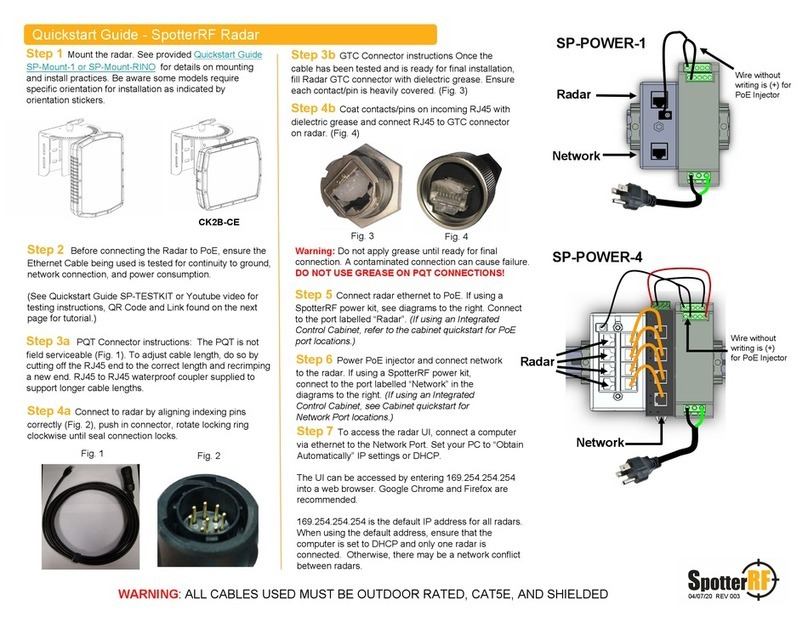
SpotterRF
SpotterRF CK2B-CE quick start guide

Garmin
Garmin Varia eRTL615 owner's manual

nanoradar
nanoradar NSR120 user manual

Endress+Hauser
Endress+Hauser Micropilot FMR50 Brief operating instructions
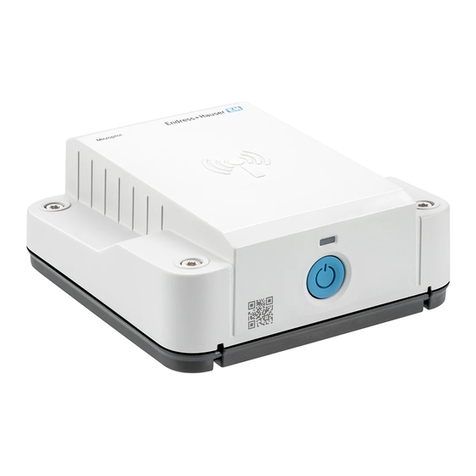
Endress+Hauser
Endress+Hauser Micropilot FWR30 operating instructions

KROHNE
KROHNE BM 702 Installation and operating instruction

Kustom Signals
Kustom Signals Talon Radar Operator's manual
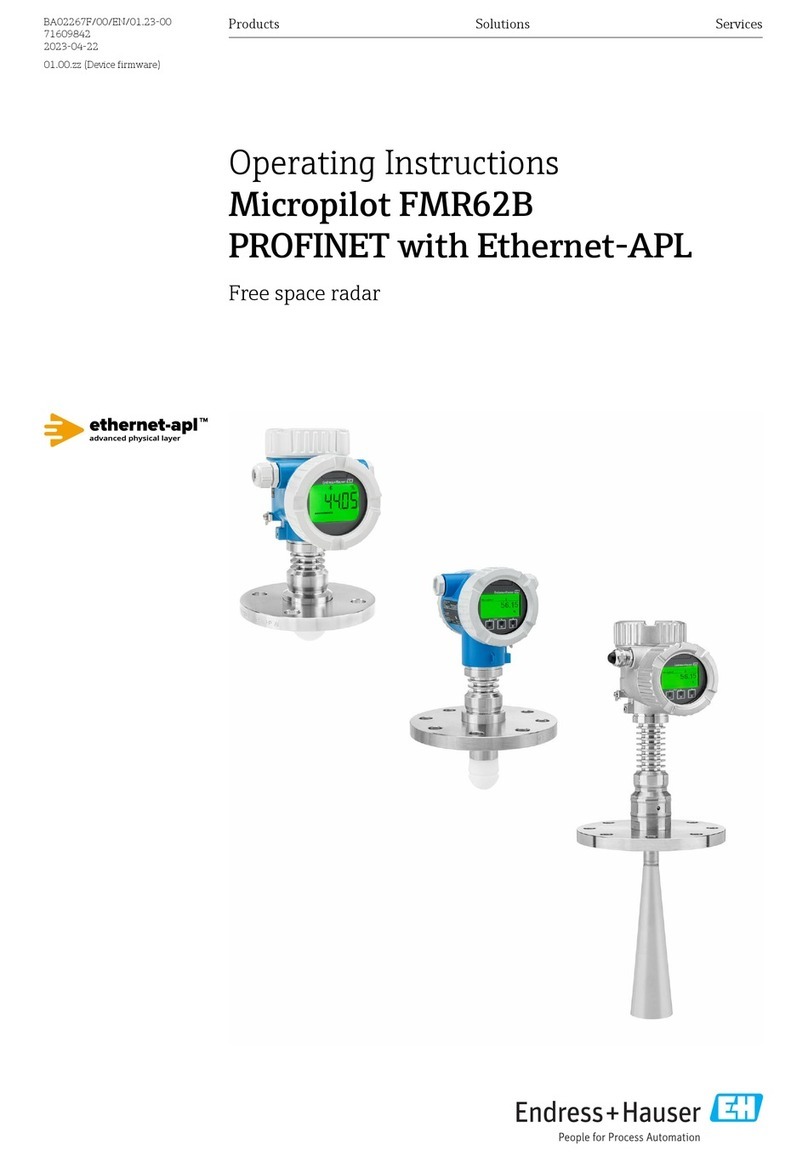
Endress+Hauser
Endress+Hauser Micropilot FMR62B PROFINET with Ethernet-APL operating instructions
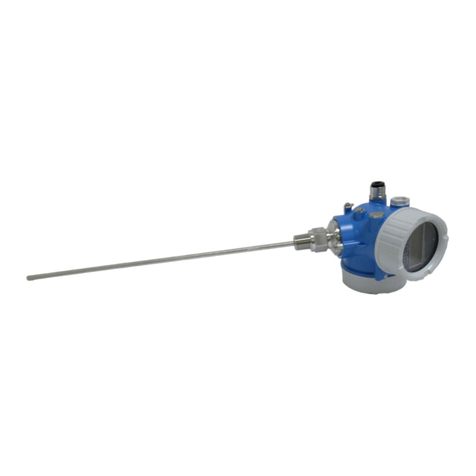
Endress+Hauser
Endress+Hauser Levelflex FMP51 Brief operating instructions

DITEC
DITEC AXP2 installation manual

CAME
CAME 001SIRCWWL manual
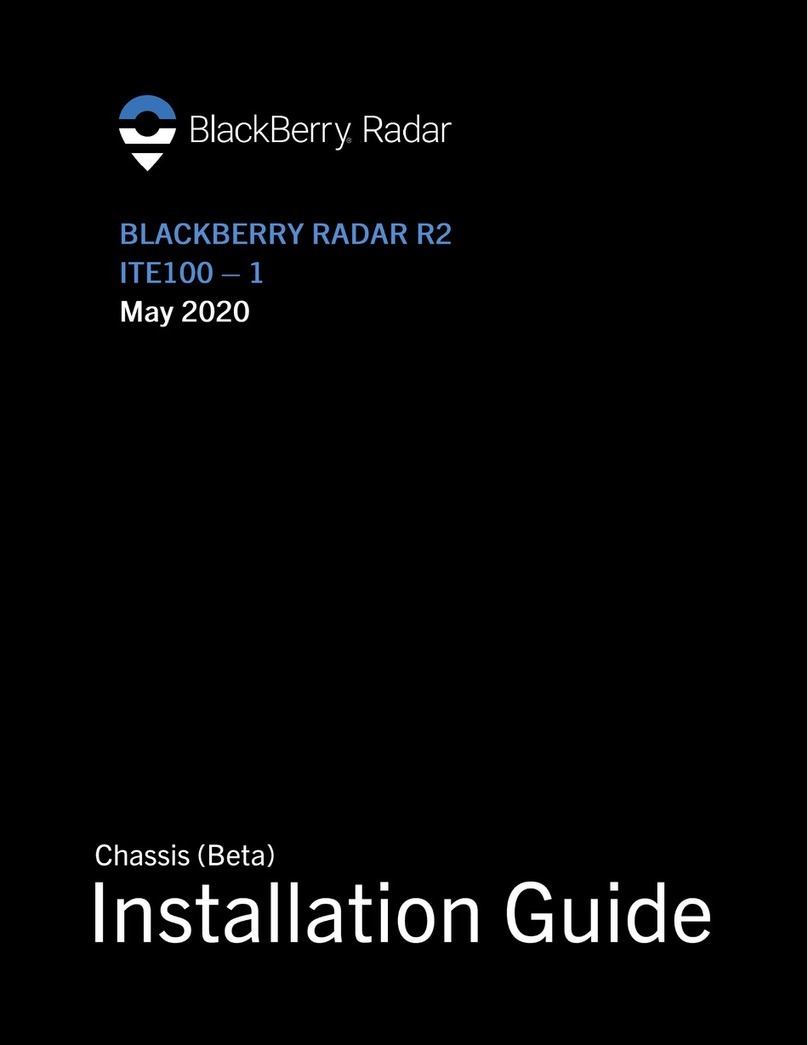
Blackbe;rry
Blackbe;rry ITE100-1 installation guide
